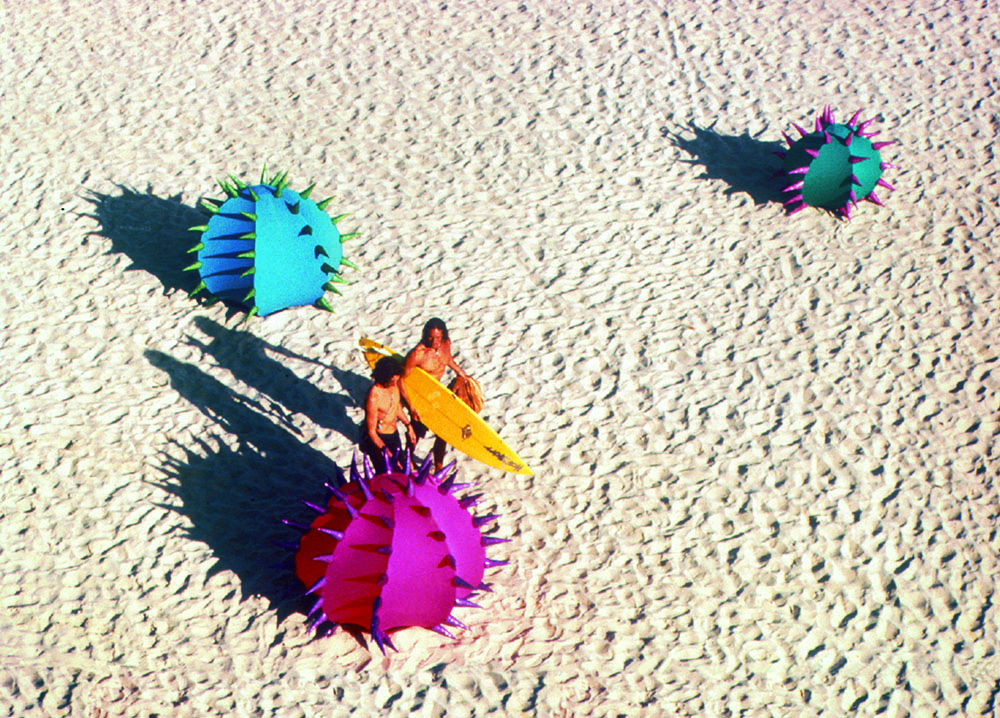
Margarita Sampson, ‘Urchins’, Sculpture by the Sea, Bondi 1997. Photo Clyde Yee
Among the principles guiding the establishment of this exhibition has been an emphasis on inclusion. In this context, a broad definition of sculpture is employed, whereby a sculpture is taken to mean a work (of art) that in some way occupies, modifies, creates or defines three dimensional space. This definition embraces works of widely diverse materials, techniques and conventions. Sculptures in the exhibition range from beautifully crafted figurative pieces to those which respond to the legacy of pop art and may be humorous in intent. Abstract and highly symbolic works sit beside conceptual installations, earth works and performance art.
As an art form, sculpture is versatile and difficult to pin down. Sculptural works can stimulate the senses, the emotions, the imagination and the intellect, arousing reactions in the spectator which range from pleasure to surprise and confrontation. Sculpture can shed light, literally and metaphysically, on the world around us and our own inner states, or suggest the possibility of a more ordered ideal where harmony reigns. Pieces can explore ideas of time, space and the universe, of illusion versus reality, of gender, ecology and a host of other concepts. Works can be serious, capricious or funny and even challenge the relevance of art itself, occupying space merely for the sake of doing so.
While the cost and difficulty of transporting their works may have prohibited some sculptors from entering this one day event, the response from more than one hundred and eighty artists reveals the abundance of sculpture being created today. Most artists submitted recent pieces and there were a number of proposals for works in progress or those to be constructed specifically for the exhibition. Unfortunately, due to spatial and logistical considerations, only approximately sixty works could be selected to be shown, but this is not to say that those left out were any less worthy than those included. During the selection process it was important for the judges to focus not only on the works themselves, but also on how each piece would look in relation to the other works installed in the site. Some works in progress were accepted on the interest of the artist’s idea and where that sculptor showed (from previous works) their potential to realise their proposal in a short period of time. Even though a number of large works were chosen to define the exhibition area, smaller works were selected to work in specific spaces or to be grouped together for impact. There are pieces which seek to dominate the space around them and those which coexist subtly and unobtrusively with the natural environment.
The place chosen for Sculpture by the Sea, the coastal path between Bondi and Tamarama, forms an edge to the built environment, with the cliffs marking the boundary between the city and sea. Some sculptors set out to use this environment as part of their works, while others point to certain aspects of the area’s history, topography and socio-political character. It is paradoxical that while sculpture often seems more natural outside, as an art form it is usually addressed more seriously within the rooms of an art gallery or museum. It takes courage for artists to position their works against such a spectacular natural backdrop.
Artists were invited to nominate their preferred position on the site, and although accommodating all of these was not possible, the final placement of works was, whenever possible, decided in consultation with the artist. There were, of course, practical and safety limitations set by the Council, the site could not be altered in any permanent way, the rocks could not be drilled into, the path damaged, trees or other foliage cut back. There were also considerations of public safety, and areas where pedestrian flow had to be considered as the path is used constantly through the day. Sculpture by the Sea has attempted to make the sculptures accessible to as many people as possible, and encouragingly, this was supported by the works entered, the majority of which sought to communicate clearly with, rather than confuse, the viewer.
The works making up this exhibition enter a space which is not devoid of a sculptural history. A trace of the area’s indigenous inhabitants remains in the Aboriginal rock engravings (regrooved in 1962), while Haydn Denmeade’s Pegasus holds an unofficially sanctioned position along the path. Other sculptures in the nearby area include the mysterious Spanish carvings on the rocks north of Bondi Beach (which may be the work of European sailors who arrived before Captain Cook or a hoax) and the two much-loved fibreglass mermaids on Ben Buckler Point (1960-mid 1970s). In addition, the exhibitions and festivals co-ordinated by the Bondi Pavilion community arts centre often incorporate sculpture.
Sculpture by the Sea did not set out to celebrate any particular form of sculpture or group of artists, nor to define any style, moment, period or movement in contemporary art. The very number, range and quality of the artists who responded to this exhibition does, however, suggest the vitality of Australian sculpture and its sculptors today.
Donna Lee Brien
Co-Curator